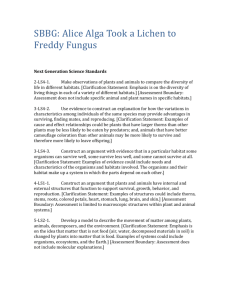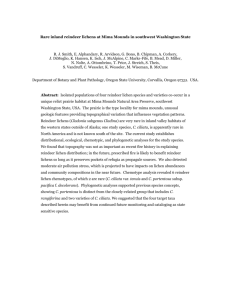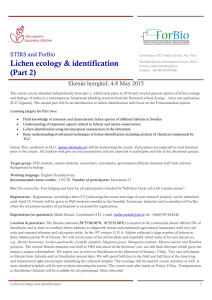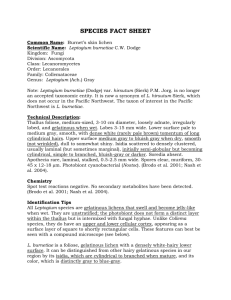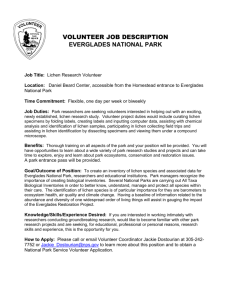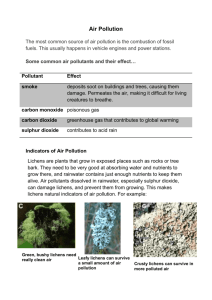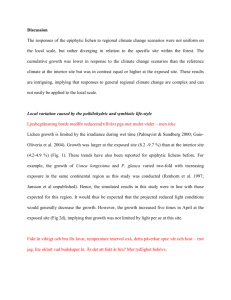Lichens in Medicine
advertisement
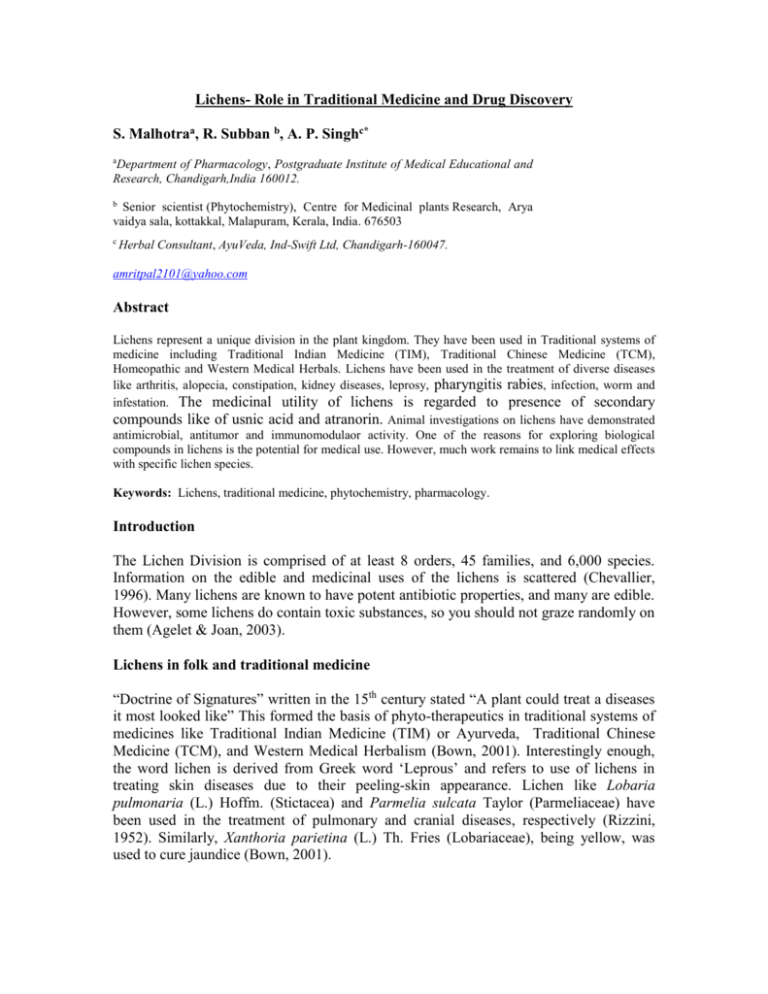
Lichens- Role in Traditional Medicine and Drug Discovery S. Malhotraa, R. Subban b, A. P. Singhc* a Department of Pharmacology, Postgraduate Institute of Medical Educational and Research, Chandigarh,India 160012. b Senior scientist (Phytochemistry), Centre for Medicinal plants Research, Arya vaidya sala, kottakkal, Malapuram, Kerala, India. 676503 c Herbal Consultant, AyuVeda, Ind-Swift Ltd, Chandigarh-160047. amritpal2101@yahoo.com Abstract Lichens represent a unique division in the plant kingdom. They have been used in Traditional systems of medicine including Traditional Indian Medicine (TIM), Traditional Chinese Medicine (TCM), Homeopathic and Western Medical Herbals. Lichens have been used in the treatment of diverse diseases like arthritis, alopecia, constipation, kidney diseases, leprosy, pharyngitis rabies, infection, worm and infestation. The medicinal utility of lichens is regarded to presence of secondary compounds like of usnic acid and atranorin. Animal investigations on lichens have demonstrated antimicrobial, antitumor and immunomodulaor activity. One of the reasons for exploring biological compounds in lichens is the potential for medical use. However, much work remains to link medical effects with specific lichen species. Keywords: Lichens, traditional medicine, phytochemistry, pharmacology. Introduction The Lichen Division is comprised of at least 8 orders, 45 families, and 6,000 species. Information on the edible and medicinal uses of the lichens is scattered (Chevallier, 1996). Many lichens are known to have potent antibiotic properties, and many are edible. However, some lichens do contain toxic substances, so you should not graze randomly on them (Agelet & Joan, 2003). Lichens in folk and traditional medicine “Doctrine of Signatures” written in the 15th century stated “A plant could treat a diseases it most looked like” This formed the basis of phyto-therapeutics in traditional systems of medicines like Traditional Indian Medicine (TIM) or Ayurveda, Traditional Chinese Medicine (TCM), and Western Medical Herbalism (Bown, 2001). Interestingly enough, the word lichen is derived from Greek word ‘Leprous’ and refers to use of lichens in treating skin diseases due to their peeling-skin appearance. Lichen like Lobaria pulmonaria (L.) Hoffm. (Stictacea) and Parmelia sulcata Taylor (Parmeliaceae) have been used in the treatment of pulmonary and cranial diseases, respectively (Rizzini, 1952). Similarly, Xanthoria parietina (L.) Th. Fries (Lobariaceae), being yellow, was used to cure jaundice (Bown, 2001). Medicinal uses of lichens are linked with folklore. The medicinal use of lichens can be traced back to the 18th dynasty (1700-1800 BC) when Evernia furfuracea (L.) Mann or (Parmeliaceae) was first used as a drug (Launert, 1981). Some lichens were claimed to be good for coughs, jaundice, rabies and restoring lost hair (Pereira, 1853). Herbal medicine texts included account of several species of lichens including Cladonia, Evernia, Lobaria, Parmelia, Peltigera, Pertusaria, Physica, Rocella, Usnea and Xanthoria (Llano, 1944 b). During the middle age, lichens figured prominently in the herbals used by practitioners. Peltigera sp., mixed with 2 drachms of black pepper, for four-days, in half-pint of warm milk, was used for rabies or hydrophobia. Linnaeus named Peltigera, in 1753 as Lichen caninus (the Dog Lichen) as it has rhizines on the lower surface that resembles teeth, hence specific epithet of canina. In traditional medicine, Peltigera canina (L.) Willd is used as liver tonic and laxative. In Ireland, Peltigera aphthosa (L.) Wiild. was used as vermifuge. People of Northern California used Letharia vulpina (L.) Hue. (Parmeliaceae) in stomach diseases. A novel species of Dictyonema was used by the Waorani as hallucinogen (Davis & Yost, 1983). In Arabian medicine, Alectoria usneoides was used in the treatment of splenomegaly (enlarged spleen). In China, Usnea diffracta Vain (Parmeliaceae) was used in medicine around 500 A.D. (Strickmann,). Hippocrates prescribed Usnea barbata for uterine ailments. In Sweden, Parmelia saxatilis (L.) Ach. is used to treat warts. In China, Lethariella cashmeriana Krog-Wei, L. sernanderi (Motyka) Obermayer, L. sinensis J. C. Wei & Jiang (Parmeliaceae) and Thamnolia vermicularis Hytter i Norden Danske (Icmadophilaceae) are used as medicated teas (Wang, et al. 2001). Usnea sp. are used in Traditional Chinese Medicine (TCM), Homeopathic system of medicine and traditional medicine in Pacific islands and New Zealand. Usnea sp are valuded for demulcent properties and finds use for mild inflammation of the oral and pharyngeal mucosa. Usnea filipendula Stirt was used in former Soviet Union for cuts and wounds (Chevallier, 1996). Spanish folk medicine has documented use of lichens in various medical aliments. Decoction of Pseudoevernia furfuracea (L.) Zopf. (Parmeliaceae) is used in Alfacar and Viznar in respiratory ailments. Ramalina bourgeana Mont. ex Nyl. (Ramalinaceae) is consumed for diuretic and stone–dissolving (lithontriptic) properties (González -Tejero, 1995). Xanthoparmelia scabrosa (Taylor) Hale (Parmeliaceae) is ingredient of various aphrodisiac formulations sold in international market. Tea prepared from Flavocetraria nivalis (L.) Kärnefelt & Thell (Parmeliaceae) is used in the treatment of motion-sickness and heart attacks of by natives of Qollahuaya Andeans in Poland (Bastien, 1983). Cetraria islandica (L.) Ach. (Parmeliaceae) commonly known as Irish moss, is valued folk remedy for lung diseases, kidney and bladder complaints as well as externally for poorly healed wounds (Bown, 2001). Traditionally it is used mild inflammation of the oral and pharyngeal mucosa. It is also valued in dyspepsia and loss of appetite. In European folk medicine, it is used in cancer treatment (Chevallier, 1996). Reindeer lichens are important medicinal agents. Cladonia rangiferina (L.) F. H. Wigg. syn. Cladina rangiferina (L.) Nyl. (Cladoniaceae) is commonly studied Reindeer lichen. Northern native people used reindeer lichen in medicinal teas to treat colds, arthritis, fevers and other problems (Perez- Llano, 1944). Reindeer lichens were also used as a poultice to relieve the ache of arthritic joints. Reindeer lichens have been taken to treat fever, jaundice constipation, convulsions, coughs, and tuberculosis (Bown, 2001). Cladonia pyxidata (L.) Hoffm. is useful remedy for whooping cough (Chevallier, 1996). Three Parmelia sp. (Parmelia chinense (Osbeck) Hale & Ahti., syn P. perlata (Huds.) Ach, P. sancti-angeli (Lynge) Hale and P. peforatum (Jacq.) A. Massal. are used for Indian drug chharila, which is used as aphrodisiac (Lal & Upreti, 1995; Kumar & Upreti, 2001). In India Parmelia chinense is used as diuretic and as liniment for headache and powder to help wounds heal. Parmelia sancti-angeli is used in Central India to treat Tinea (ringworm) like disease. Ash of the lichen, mixed with mustard or linseed oil, is applied to the affected area. Parmelia peforatum is medically recognized in Afghanistan (Chandra & Singh, 1971). Parmelia nepalense (Talyor) Hale ex Sipman is used in Nepal in the treatment of toothache and sore throat (Kumar, Banskota & Manandhar, 1996). In Western Himalayas Thamnolia vermicularis (Schwartz) Ach. (Icmadophilaceae) is used as antiseptic (Negi & Kareem, 1996). In Sikkim, Heterodermia diademata (Talyor) D.D. Awas. (Physciaceae) is used for cuts and wounds (Saklani & Upreti, 1992). Phytochemical and pharmacological investigations Lichen metabolites exert a wide variety of biological actions including antibiotic, antimycobacterial, antiviral, anti-inflammatory, analgesic, antipyretic, antiproliferative and cytotoxic effects. Even though these manifold activities of lichen metabolites have now been recognized, their therapeutic potential has not yet been fully explored and thus remains pharmaceutically unexploited (Müller, 2002). The utility of lichens is due of range of secondary compounds produced by them (Boustie & Grube, 2005). Antimicrobial activity Antibacterial Antibiotic properties of the lichens are of special interest to the scientists (Lawrey, 1986). According to one estimate, 50 % of all lichens have antibiotic properties (Sharnoff, 1997). Burkholder (1944) was pioneer initiating research on lichens as antibacterial agents. He tested 42 lichens for antibiotic property and 27 were reported to inhibit growth of bacteria (Burkholder et al 1944; Bylicka, 1952; Vartia, 1973). Parmelia Physodes (L.) Ach. was reported to be antibiotic (Mordraksi, 1956). Usnic acid is wide-spectrum antibiotic characterized from the lichens (Shibamoto & Wei, 1984, Rowe et al. 1991; Dobrescu et al. 1993; Abo-Khatwa et al. 1996; Cocchietto, Skert & Nimis, 2002). Vulpinic acid has mild antibiotic property (Lauterwein et al. 1995). Atranorin has been found to be much less biologically active than usnic acid and vulpinic acid (Lawrey, 1986). Usnic acid, evernic acid, and vulpinic acid inhibited the growth of gram positive bacteria Staphylococcus aureus, Bacillus subtilis, and Bacillus megaterium, but the acids had no affect on the gram negative bacteria Escherichia coli or Pseudomonas aeruginosa (Lawrey, 1986). Usnic acid isolated from lichens from south Spain has high activity against Gram-positive bacteria (Rowe et al. 1999). Acetone, diethyl ether and ethanol extracts of the lichen Cetraria aculeata (Schreber) Fr. and its active constituent protolichesterinic acid were tested positive against Escherichia coli, Staphylococcus aureus, Aeromonas hydrophila, Proteus vulgaris, Streptococcus faecalis, Bacillus cereus, Bacillus subtilis, Pseudomonas aeruginosa, and Listeria monocytogenes (Turk et al. 2003). Alectosarmentin, (-)-usnic acid, physodic acid and 8'-O-ethyl-beta-alectoronic acid isolated from the alcoholic extract of the lichen Alectoria sarmentosa (Ach.) Ach. (Alectoriaceae) showed antimicrobial activity (Gollapudi et al. 1994) Hypogymnia apinnata (atranorin), Letharia columbiana (vulpinic acid), Lobaria pulmonaria (Stictic acid, constictic acid, & norstictic acid) and Usnea filipendula (Usnic acid & salazinic acid) have been reported to have significant antibiotic activity against Micrococcus luteus, Staphylococcus aureus, Salmonella gallinarum and Serratia marcescens respectively (Crockett et al. 2003). The acetone and methanol extracts of Lasallia pustulata (L.) Méret. (Umbilicariaceae), Parmelia sulcata Taylor, and Umbilicaria crustulosa (Ach.) Frey (Umbilicariaceae), manifested antibacterial activity against the majority of species of bacteria tested, in addition to selective antifungal activity (Rankovic, Misic & Sukdolak, 2007). Acetone, chloroform, diethyl ether, methanol, and petroleum ether extracts of Parmelia sulcata and its constituent (salazinic acid) demonstrated antibacterial activity against Aeromonas hydrophila, Bacillus cereus, Bacillus subtilis, Listeria monocytogenes, Proteus vulgaris, Yersinia enterocolitica, Staphylococcus aureus, Streptococcus faecalis, Candida albicans, Candida glabrata, Aspergillus niger, Aspergillus fumigatus, and Penicillium notatum (Candan et al 2007). 3-hydroxyphysodic acid isolated from Hypogymnia tubulosa (Schaerer) Havaas (Parmeliaceae) showed antimicrobial activity against Aeromonas hydrophila, Bacillus cereus, Bacillus subtilis, Escherichia coli, Klebsiella pneumoniae, Listeria monocytogenes, Proteus vulgaris, Salmonella typhimurium, Staphylococcus aureus, Streptococcus faecalis, and Candida albicans (Yilam et al. 2005). Extracts of Xanthoparmelia pokornyi (Vainio) Hale (Parmeliaceae) and its constituents (gyrophoric and stenosporic acid) have been reported to be potential antimicrobials (Candan et al 2006). Extracts of Pseudevernia furfuracea and its constituents (physodic acid, chloroatranorin, atranorin, and olivetoric acid) have significant antimicrobial activity (Turk et al. 2006). Hirtusneanoside isolated from Usnea hirta (L.) Wigg. (Parmeliaceae) showed growth inhibitory activities against Gram-positive bacteria (Renzaka & Sigler, 2007). Antifungal Parietin, anthraquinone isolated from methanol extract of Caloplaca cerina (Ehrh. ex Hedwig) Th.Fr. (Teloschistaceae) has been reported to have significant antifungal activity (Manojlovic et al. 2005). Extracts of Andean lichens Protousnea poeppigii (Nees & Flot.) Vain. (Parmeliaceae) and Usnea florida var. rigida Acharius demonstrated antimicrobial activity against the pathogenic fungi Microsporum gypseum, Trichophyton mentagrophytes and T. rubrum. isodivaricatic acid, 5-propylresorcinol, divaricatinic acid and usnic acid were identified as antifungal agents (Schmeda-Hirschmann et al. 2007). Antiviral Usnic acid isolated from Teloschistes chrysophthalmus (L.) Th. Fr. (Teloschistaceae) and parietin isolated from Ramalina celastri demonstrated antiviral activity against the arena viruses Junin and Tacaribe (Fazio et al. 2007). Antioxidant activity Phenolic constituents from the lichen Parmotrema stuppeum (Nyl.) Hale (Parmeliaceae) including methyl orsenillate, orsenillic acid, atranorin and lecanoric acid showed moderate antioxidant activity (Jayapraksha & Rao, 2000). An animal study reported antioxidant activity of lichen Cetraria islandica (Gülçin et al. 2002). Stictic acid derivatives from the lichen Usnea articulata (Ach.) Motyka were reported to have significant (Lohèzic-Le Dèvèhat F 2007). Antitumor activity Pannarin inhibited cell growth and induces cell death in human prostate carcinoma DU145 cells (Maier et al. 1999).The orcinol derivatives tenuiorin and methyl orsellinate present in extract of Peltigera leucophlebia (Nyl.) Gyeln. (Peltigeraceae) exhibited in vitro inhibitory activity against 15-lipoxygenase from soybeans. A correlation has been observed between 5-lipoxygenase inhibition and antiproliferative effects for related lichen metabolites. On this account, tenuiorin and methyl orsellinate were further tested for antiproliferative activity on cultured human breast, pancreatic and colon cancer cell lines. Methyl orsellinate lacked antiproliferative activity but tenuiorin depicted moderate activity (Ingolfsdottir et al. 2002). Bianthraquinone glycosides, colleflaccinosides isolated from Collema flaccidum (Ach.) Ach. (Collemataceae) collected in Israel and Russia, were reported to have antitumor activity (Rezanka & Dembitsky, 2006). Immunomodulator activity Heteroglycans and a beta-glucan isolated from Thamnolia vermicularis var. subuliformis were tested for in vitro immunomodulating activity and reported to have various influences on the immune system (Omarsdottir, Freysdottir & Olafsdottir, 2007). Tyrosinase-inhibitory activity Methanol extracts of Graphina glaucorufa (Vain.) Zahlbr., Graphina multistriata Müll. Arg., Graphina salacinilabiata Patw. & CR Kulk., Graphis assamensis Nagarkar & Patw., Graphis nakanishiana Patw. & CR Kulk, and Phaeographopsis indica (Patw. & Nagarkar) Sipman & Aptroot (Graphidaceae) have significant tyrosinase-inhibitory activity (Behera, Adawadkar & Makhija, 2006). Methanolic extracts of the edible and medicinal lichens, Umbilicaria (Gyrophora) esculenta and Usnea longissima manifested in vitro melanogenesis inhibitory. It was concluded that lichen extracts affected the activity of tyrosinase via the inhibition of tyrosinase glycosylation (Kim & Cho, 2007). Recent phytochemical investigations on lichens Two tridepsides (2,4-Di-O-methylgyrophoric acid and 2,4,5-tri-O-methylhiascic acid) have been isolated from Parmelia damaziana Zahlbr.,(Elix, Jayanthi & Leznoff., 1981). Lasallic acid, a tridepside has been reported from Lasallia asiae-orientalis Whittaker & Margulis (Umbilicariaceae) (Narui et al. 1996). -butyrolactone acid, (-)-isomuronic acid and gyrophoric acid have been isolated from Punctelia microsticta (Mull. Arg.) Krog (Parmeliaceae) (Maier et al. 1999). Dasypogalactone, a lactone has been reported from Usnea dasygopa Rohl growing in Indonesia (Suwarso et al 1999). . A new red anthraquinone, draculone, has been isolated from the corticolous tropical lichen Melanotheca cruenta (Mont.) Miill. (Trypetheliaceae) together with anthraquinone pigment haematommone (Mathey, Spiteller & Steglich, 2002). Beta-orcinol metabolites viz hypotrachynic acid, deoxystictic acid, cryptostictinolide and 8'-methylconstictic acid have been reported from the lichen Hypotrachyna revoluta (Flörke) Hale. (Parmeliaceae) (Papadopoulou et al. 2007). References: Abo-Khatwa AN, Al-Robia AA, Jawhari DA. 1996. Isolation and identification of usnic acid and atranorin from some Saudi Arabian lichens. Arab Gulf Journal of Scientific Research 15: 15-28. Agelet A, Vallës Joan. 2003. Studies on pharmaceutical ethnobotany in the region of Pallars (Pyrenees, Catalonia, Iberian Peninsula). Part III. Medicinal uses of non-vascular plants. Journal of Ethno pharmacology 84(2-3): 229-234. Bastien JW. 1983. Pharmacopoeia of the Qollahuaya Andeans. Journal of Ethnopharmacology 8: 97-111. Behera BC, Adawadkar B, Makhija U. 2006. Tyrosinase-inhibitory activity in some species of the lichen family Graphidaceae. Journal of Herbal Pharmacotherapy 6(1):5569. Boustie J, Grube M. 2005. Lichens-a promising source of bioactive secondary metabolites. Plant Genetic Resources 3:273-278. Bown D. 2001. Encyclopedia of Herbs and their Uses. Dorling Kindersley, London. Burkholder PR et al. 1944. Antibiotic activity of lichens. Proceedings of the National Academy of Sciences of the U. S. A. 30(9): 250-255. Bylicka H. 1952. Antibiotics of lichens Acta Microbiologica Polonica 1:185. Candan, M et al. 2006. Antimicrobial activity of extracts of the lichen Xanthoparmelia pokornyi and its gyrophoric and stenosporic acid constituents. Zeitschrift für Naturforschung 61(5-6):319-23. Candan, M et al. 2007. Antimicrobial activity of extracts of the lichen Parmelia sulcata and its salazinic acid constituent. Zeitschrift für Naturforschung 62(7-8):619-21. Chandra S & Singh A 1971. A lichen crude drug (chharila) from India. Journal of Research in Indian Medicine 6:209-215. Chevallier A 1996. The Encyclopedia of Medicinal Plants Dorling Kindersley. London Crockett M et al. 2003. Antibacterial Properties of four Pacific Northeast Lichens. Botany 465 Lichenology at Oregon State University. Davis EW, Yost JA. 1983. Novel hallucinogens from Eastern Ecuador. Botanical Museum Leaflets. Harvard University 29(3): 291-295. Dobrescu, D. et al. 1993. Contributions to the complex study of some lichens--Usnea genus. Pharmacological studies on Usnea barbata and Usnea hirta species. Rom J Physiol 30(1-2): 101-107. Fazio AT et al. 2007. Lichen secondary metabolites from the cultured lichen mycobionts of Teloschistes chrysophthalmus and Ramalina celastri and their antiviral activities. Zeitschrift für Naturforschung 62(7-8):543-9. Gollapudi SR et al. 1994. Alectosarmentin, a new antimicrobial dibenzofuranoid lactol from the lichen, Alectoria sarmentosa. Journal of Natural Product 57(7):934-8. González-Tejero MR et al 1995. Three lichen used in popular medicine in Eastern Andalucia (Spain). Economic Botany 49(1): 96-98. Gülçin I et al. 2002. Determination of antioxidant activity of lichen Cetraria islandica (L) Ach. Journal of Ethnopharmacology 79(3):325-329 Ingolfsdottir K et al. 2002. Effects of tenuiorin and methyl orsellinate from the lichen Peltigera leucophlebia on 5-/15-lipoxygenases and proliferation of malignant cell lines in vitro. Phytomedicine 9(7):654-8. JA Elix, VK Jayanthi and CC Leznoff. 1981. 2, 4-Di-O-methylgyrophoric acid and 2, 4, 5-tri-O-methylhiascic acid. New tridepsides from Parmelia damaziana. Australian Journal of Chemistry 34(8):1757-1761. Jayapraksha GK, Rao LJ. 2000. Phenolic constituents from the lichen Parmotrema stuppeum (Nyl.) Hale and their antioxidant activity. Zeitschrift für Naturforschung 55(1112):1018-22. Kim MS, Cho HB. 2007. Melanogenesis Inhibitory Effects of Methanolic Extracts of Umbilicaria esculenta and Usnea longissima. Journal of Microbiology 45(6):578-82. Kumar K, Upreti DK 2001. Parmelia sp. (lichens) in ancient medicinal plant lore of India. Economic Botany 55(3): 458-459. Kumar S, Banskota ah & Manandhar MD 1996. Isolation and identification of some chemical constituents of Parmelia nepalensis. Planta Medica 62:93-94, Lal BM, Upreti DK. 1995. Ethno botanical notes on three Indian lichens. Lichenologist 27(1): 77-99. Launert E. 1981. Edible and Medicinal Plants. Hamlyn. Lauterwein M et al. 1995. In vitro activities of the lichen secondary metabolites vulpinic acid, (+)-usnic acid, and (-)-usnic acid against aerobic and anaerobic microorganisms. Antimicrobial Agents and Chemotherapy 39(11): 2541-2543. Lawrey JD. 1986. Biological role of lichen substances. The Byrologist 89:111-122. Lawrey JD. 1986. Biological role of lichen substances. The Bryologist 89:111-122. Cocchietto M, Skert N, Nimis PL. 2002. A review on usnic acid, an interesting natural compound. Naturwissenschaften 89: 137-146. Lohèzic-Le Dèvèhat F et al. 2007. Stictic acid derivatives from the lichen Usnea articulata and their antioxidant activities. Journal of Natural Product 70(7):1218-20. Maier MS et al. 1999. Revised Structure for (-)-Dihydropertusaric Acid, a Butyrolactone Acid from the Lichen Punctelia microsticta Journal of Natural Products 62(11):1565 -1567. Manojlovic NT et al. 2005. Antifungal activity of Rubia tinctorum, Rhamnus frangula and Caloplaca cerina. Fitoterapia 76(2):244-6. Mathey A, Spiteller P, Steglich W. 2002. Draculone, a new anthraquinone pigment from the tropical lichen Melanotheca cruenta. Zeitschrift für Naturforschung 57(7-8):565-7. Mordraksi M. 1956. Antibiotics from lichens of Parmelia Physodes species. Archivum Immunologiae et Therapiae Exeprimentalis Immunolology (Warsz) 4:299-334. Müller K. 2002. Pharmaceutically relevant metabolites from lichens. Applied Microbiology and Biotechnology 56(1/2): 9-16. Narui T. et al. 1996. Lasallic acid, a tridepside from the lichen, Lasallia asiae-orientalis. Phytochemistry 42(3): 839-842. Negi HR, Kareem A. 1996. Lichens: the unsung heroes. Amruth 1:3-6. Omarsdottir S, Freysdottir J, Olafsdottir ES. 2007. Immunomodulating polysaccharides from the lichen Thamnolia vermicularis var. subuliformis. Phytomedicine 14(2-3):17984. Papadopoulou P. et al. 2007. Beta-orcinol metabolites from the lichen Hypotrachyna revoluta. Molecules 12:12(5):997-1005. Pereira J. 1853. The Elements of Material Medica and Therapeutics, Vol. 2, 3th American ed. Perez- Llano GA. 1944. Lichens. Their biological and economic significance The Botanical Review 10:1. Perez- Llano GA. 1944b. Economic uses of lichens. Economic Botany 2:15-45. Rankovic B, Misic M. Sukdolak S. 2007. Evaluation of antimicrobial activity of the lichens Lasallia pustulata, Parmelia sulcata, Umbilicaria crustulosa and Umbilicaria cylindrica. Mikrobiologya 76(6): 817-821. Renzaka T, Sigler K. 2007. Hirtusneanoside, an unsymmetrical dimeric tetrahydroxanthone from the lichen Usnea hirta. Journal of Natural Product 70(9):148791. Rezanka T, Dembitsky VM. 2006. The colleflaccinosides, two chiral bianthraquinone glycosides with antitumor activity from the lichen Collema flaccidum collected in Israel and Russia. Natural Product Research 20(10):969-80. Rizzini, CT. 1952. The uses of lichens in medicine. Bras Med. 66(38-39): 589-96. Rowe G et al. 1999. Some lichen products have antimicrobial activity. Zeitschrift für Naturforschung 54(7-8):605-9. Rowe JG et al 1991. Additional contribution to the study of the antimicrobial activity and identification of lichenic substances in some lichens from Southern Spain. Ann. Pharm. Fr. 49(5): 278-285. Russo A et al. 2006. Pannarin inhibits cell growth and induces cell death in human prostate carcinoma DU-145 cells. Anticancer Drugs 17(10):1163-9 Saklani A, Upreti DK. 1992. Folk uses of some lichens of Sikkim. Journal of Ethnopharmacology 37:229-233. Schmeda-Hirschmann G et al. 2007. A new antifungal and antiprotozoal depside from the Andean lichen Protousnea poeppigii. Phytotherapy Research [Epub ahead of print] Sharnoff, S. D. 1997. Lichens and people. Online: http://www.lichen.com/people.html Shibamoto T, Wei CI. 1984. Mutagenicity of lichen constituents. Environmental Mutagenesis 6: 757-762. Suwarso W P et al 1999. Dasypogalactone , a new C3-Symmetric Macrolactone from the Indonesian Lichen Usnea dasypoga Rohl. European Journal of Organic Chemistry 7:1719-21. Turk et al. 2003. The antimicrobial activity of extracts of the lichen Cetraria aculeata and its protolichesterinic acid constituent. Zeitschrift für Naturforschung 58(11-12):850-4. Turk H. et al. 2006. Antimicrobial activity of extracts of chemical races of the lichen Pseudevernia furfuracea and their physodic acid, chloroatranorin, atranorin, and olivetoric acid constituents. Zeitschrift für Naturforschung. 61(7-8):499-507. Vartia KO. 1973. Antibiotics in lichens. The Lichens (eds. V. Ahmadjian and M. E. Hale), Academic Press, New York, pp. 547-561. Wang. LI-S et al. 2001. Ethnic Uses of Lichens in Yunnan, China. The Lichenologist 104(3): 345-349. Yilam M. et al. 2005. The antimicrobial activity of extracts of the lichen Hypogymnia tubulosa and its 3-hydroxyphysodic acid constituent. Zeitschrift für Naturforschung 60(12):35-8.


